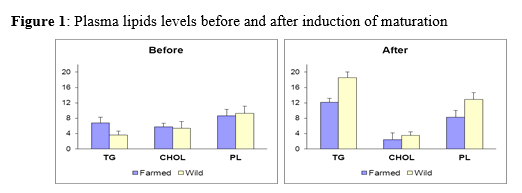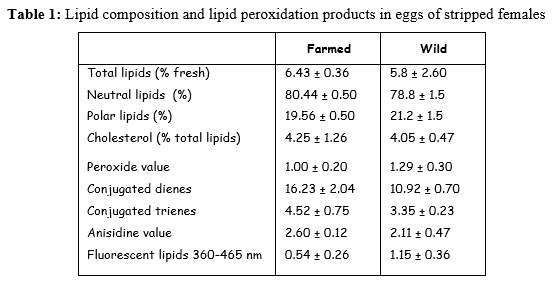COMPARISON of BROODSTOCK lipid STORES IN FARMED AND WILD European eel (Anguilla anguilla) in link with reproductive performance
Introduction
Reproduction of the European eel is a focus research area for a self-sustained aquaculture of this species. Among the numerous factors that could affect reproductive performances, the nutritional condition of broodstock fish is of particular importance in eel as feeding ceases concomitant with silvering in nature and in captivity at the transfer to saltwater prior to induction of maturation. Like many marine fish species, eel utilise stored lipid reserves during maturation of the ovaries highlighting the importance of pre-spawning nutrition, in particular the role of liposoluble compounds.
This study aimed to compare the constitution of lipid reserves (lipogenic capacity, plasma lipids, muscle lipid composition) and the lipid composition of the eggs between farmed and wild European eel in link with the spawn quality.
Material and methods
Farmed female eels were reared under standard conditions in a fish farm and fed for 8 months with an experimental diet (47% protein, 25% lipid) having a fatty acid ratio of 1.7 for DHA/EPA and 0.26 for ARA/EPA (Støttrup et al., 2013). Wild eels were collected from Lake Vandet, North Jutland, Denmark.
Eels were then transferred to dedicated research facility (DTU, Denmark) and conditioned by increasing salinity from 0 to 36 ‰ over 10 days. The general rearing conditions were: salinity 36‰, temperature 20°C and natural photoperiod. Vitellogenesis was induced by a weekly injection of salmon pituitary extract (SPE) until final maturation, which was induced by injection of dihydroxyprogesterone (DHP) (Tomkiewicz, 2012). Samples of liver, muscle, plasma were taken from females obtained before the induction of maturation and females obtained after stripping to determine the activity of lipogenic enzymes in liver and muscle, the level of circulating lipids, the lipid composition of muscle. Samples of eggs were also taken after stripping to analyze lipid composition and lipid peroxidation products.
Results and discussion
The initial body weight of wild females is lower than that of farmed eels (mean around 641g vs 870 g respectively).
In both groups, the activity of glucose 6-phosphate dehydrogenase (G6PD) is very low in muscle, with however higher values in wild eels. The activity of fatty acid synthase (FAS) was not detectable in muscle whatever the group. In the liver, we did not find any significant difference for lipogenic enzymes activities between groups and also related to maturation stage.
Before induction of maturation, we did not find differences in plasma cholesterol and phospholipids levels between the 2 groups, whereas plasma triglycerides (TG) are lower in wild eels (Figure 1). After spawning, plasma cholesterol decreases and triglycerides increases whatever the groups, with a higher level of circulating TG in wild eels (18.6 g/l) compared to farmed eels (12.2 g/l).
Muscle lipid content is lower in wild eels than in farmed eels with around 96% neutral lipids (NL) and 4% polar lipids (PL) in both groups. This difference could be related to the lower body weight of wild females. After maturation muscle lipid level tended to be higher, due to the strong reduction in muscle mass. Around 50% of total lipids stored in muscle are mobilized during maturation.
Egg lipid content is similar in farmed and wild eels, respectively 6.4 and 5.8% total lipids with about 80% NL, 20% PL and 4% cholesterol (Table 1). No clear difference in peroxide value, conjugated dienes and trienes, anisidine value and lipid-soluble fluorescent products was observed between the 2 groups.
The number of females producing eggs that were successfully fertilized was similar between the 2 groups whereas the number of embryos and larvae produced was higher in wild females. These results seem to indicate that these differences in reproductive performance between farmed and wild eels are not linked to broodstock lipid stores and eggs lipid composition.
Acknowledgments
The study was conducted as part of the FP7 project "Reproduction of European eel: Towards a Self-sustained Aquaculture" (PRO-EEL, No. 245257).
References
Støttrup, J.G., Jacobsen, C., Tomkiewicz, J., Jarlbæk, H. Modification of essential fatty acid composition in broodstock of cultured European eel Anguilla anguilla L. 2013. Aquaculture Nutrition, 19, 172-185.
Tomkiewicz, J. (Ed.). 2012. Reproduction of European Eel in Aquaculture (REEL): Consolidation and new production methods. DTU Aqua Report No 249-2012. National Institute of Aquatic Resources, Technical University of Denmark, Copenhagen Denmark. 47 p..

